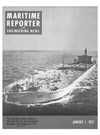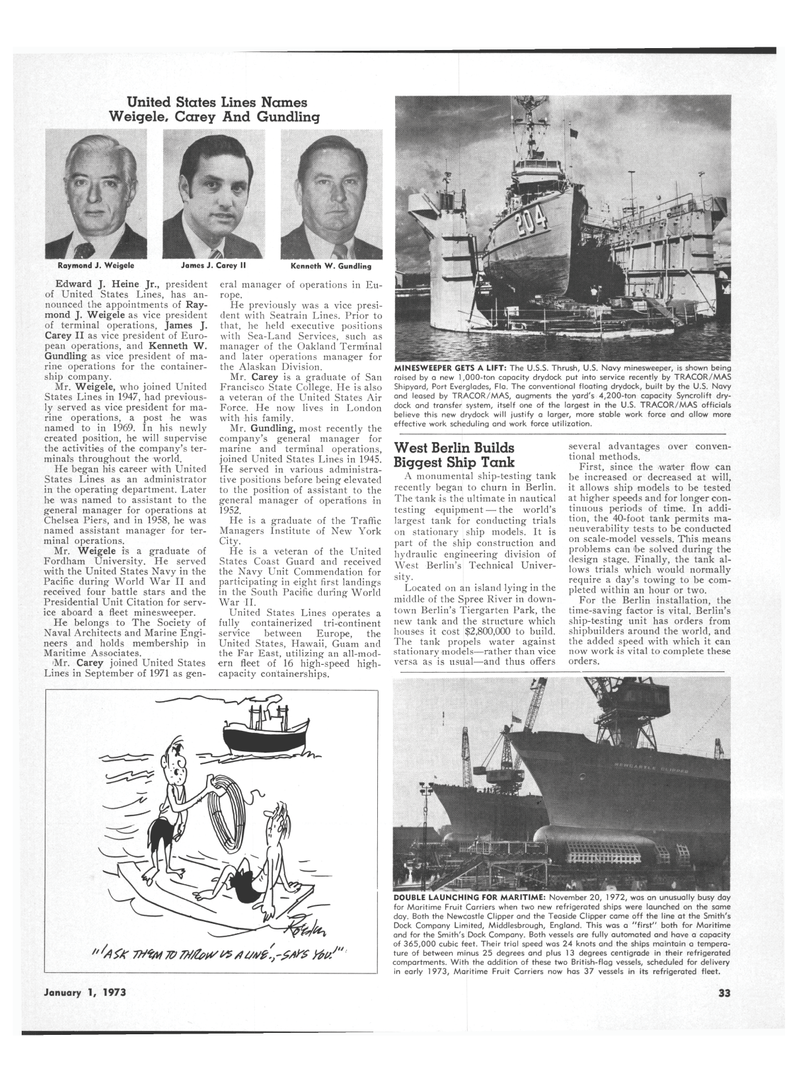
Page 31: of Maritime Reporter Magazine (January 1973)
Read this page in Pdf, Flash or Html5 edition of January 1973 Maritime Reporter Magazine
United States Lines Names
Weigele, Carey And Gundling
Raymond J. Weigele James J. Carey II Kenneth W. Gundling
MINESWEEPER GETS A LIFT: The U.S.S. Thrush, U.S. Navy minesweeper, is shown being raised by a new 1,000-ton capacity drydock put into service recently by TRACOR/MAS
Shipyard, Port Everglades, Fla. The conventional floating drydock, built by the U.S. Navy and leased by TRACOR/MAS, augments the yard's 4,200-ton capacity Syncrolift dry- dock and transfer system, itself one of the largest in the U.S. TRACOR/MAS officials believe this new drydock will justify a larger, more stable work force and allow more effective work scheduling and work force utilization.
Edward J. Heine Jr., president of United States Lines, has an- nounced the appointments of Ray- mond J. Weigele as vice president of terminal operations, James J.
Carey II as vice president of Euro- pean operations, and Kenneth W.
Gundling as vice president of ma- rine operations for the container- ship company.
Mr. Weigele, who joined United
States Lines in 1947, had previous- ly served as vice president for ma- rine operations, a post he was named to in 1969. In his newly created position, he will supervise the activities of the company's ter- minals throughout the world.
He began his career with United
States Lines as an administrator in the operating department. Later he was named to assistant to the general manager for operations at
Chelsea Piers, and in 1958, he was named assistant manager for ter- minal operations.
Mr. Weigele is a graduate of
Fordham University. He served with the United States Navy in the
Pacific during World War II and received four battle stars and the
Presidential Unit Citation for serv- ice aboard a fleet minesweeper.
He belongs to The Society of
Naval Architects and Marine Engi- neers and holds membership in
Maritime Associates. 'Mr. Carey joined United States
Lines in September of 1971 as gen- eral manager of operations in Eu- rope.
He previously was a vice presi- dent with Seatrain Lines. Prior to that, he held executive positions with Sea-Land Services, such as manager of the Oakland Terminal and later operations manager for the Alaskan Division.
Mr. Carey is a graduate of San
Francisco State College. He is also a veteran of the United State's Air
Force. He now lives in London with his family.
Mr. Gundling, most recently the company's general manager for marine and terminal operations, joined United States Lines in 1945.
He served in various administra- tive positions before being elevated to the position of assistant to the general manager of operations in 1952.
He is a graduate of the Traffic
Managers Institute of New York
City.
He is a veteran of the United
States Coast Guard and received the Navy Unit Commendation for participating in eight first landings in the South Pacific during World
War II.
United States Lines operates a fully containerized tri-continent service between Europe, the
United States, Hawaii, Guam and the Far East, utilizing an all-mod- ern fleet of 16 high-speed high- capacity containerships.
West Berlin Builds
Biggest Ship Tank
A monumental ship-testing tank recently began to churn in Berlin.
The 'tank is the ultimate in nautical testing equipment — the world's largest tank for conducting trials on stationary ship models. It is part of the ship construction and hydraulic engineering division of
West Berlin's Technical Univer- sity.
Located on an island lying in the middle of the Spree River in down- town Berlin's Tiergarten Park, the new tank and the structure which houses it cost $2,800,000 to build.
The tank propels water against stationary-models—rather than vice versa as is usual—and thus offers several advantages over conven- tional methods.
First, since the water flow can be increased or decreased at will, it allows ship models to be tested at higher speeds and for longer con- tinuous periods of time. In addi- tion, the 40-foot tank permits ma- neuverability tests to be conducted on scale-model vessels. This means problems can (be solved during the design stage. Finally, the tank al- lows trials which would normally require a day's towing to be com- pleted within an hour or two.
For the Berlin installation, the time-saving factor is vital. Berlin's ship-testing unit has orders from shipbuilders around the world, and the added speed with which it can now work is vital to complete these orders.
January 1, 1973
DOUBLE LAUNCHING FOR MARITIME: November 20, 1972, was an unusually busy day for Maritime Fruit Carriers when two new refrigerated ships were launched on the same day. Both the Newcastle Clipper and the Teaside Clipper came off the line at the Smith's
Dock Company Limited, Middlesbrough, England. This was a "first" both for Maritime and for the Smith's Dock Company. Both vessels are fully automated and have a capacity of 365,000 cubic feet. Their trial speed was 24 knots and the ships maintain a tempera- ture of between minus 25 degrees and plus 13 degrees centigrade in their refrigerated compartments. With the addition of these two British-flag vessels, scheduled for delivery in early 1 973, Maritime Fruit Carriers now has 37 vessels in its refrigerated fleet. 33

 30
30

 32
32
